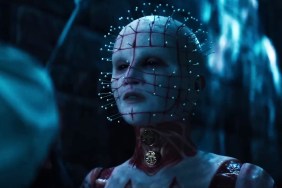Maybe they’re warming up.
Ten years ago, Sega was saved from total annihilation by the selfless heroics of a true gaming legend – Segata Sanshiro. With the fire of life rekindled, Sega pulled its foot out of the grave and came back with a cast of iconic characters, including NiGHTS, AiAi, Ulala, and Beat. But try as they might, the newcomers couldn’t keep the fire from fizzling into the darkness.
[image1]Where are the protégés of Sega now? Are they still battling evil and saving the world in honor of Segata Sanshiro’s sacrifice? Not quite. They’re playing tennis.
Ripping a page or two from the playbook of Mario’s sports games, Sega Superstars Tennis (SST) is best taken lightly with a dose of nostalgia injected in the rear. As expected, the reality of tennis has been whittled down to the basics to make room for the outrageous returns and courtside antics of the Sega lineup. I’m more of a ping-pong kind of guy, so that’s fine by me. I’m just here to see some old friends back in action.
Sonic is the obvious poster-child of Sega stardom, but who can forget Kid Chameleon, Joe Musashi of Shinobi, “that rollerblading kid” in Streets of Rage 2, or the morphing duo of Altered Beast? Apparently, Sega can. They barely thought past the Dreamcast when diving through the timeline for SST competitors. Eight initial characters and eight unlockable ones could make a healthy crew, but not when the majority are second-stringers from the same six games.
NiGHTS, Beat, and Tails are cool in my book, but Amy… seriously? As far as I’m concerned, her rank on the star-meter is somewhere between Random Zombie #38 and that creepy Welch’s girl. Alex Kidd and Thunderhead of Golden Axe make appearances, but it simply isn’t enough. If Sega really wanted to do right by their fans, there is one name they simply couldn’t do without – Ecco. Who in their right mind wouldn’t want to see a beached dolphin with a racquet?
Even with the limited cast, just think of the wild concert of powerhouse moves that awaits. Imagine Sonic smashing the sound barrier as the ball obliterates the net, AiAi’s lob falling amid a hail of monkey balls, or one of Dr. Eggman’s monstrous contraptions tearing up the court. Well, you might as well just take those images and file them away in the folder of things that could have been. What’s left is something akin to an upgraded version of Pong.
[image2]Each character has a defining attribute, like speed, control, or spin, but the only noticeable difference is based on height. While the diminutive Amigo shakes his maracas to a heart-attack rhythm as he tries to run across the court, Dr. Eggman casually covers the green with freakishly long arms.
Play well, and you’ll be rewarded with the temporary Superstar State. This is when all the special moves of my fantasies should have come to life. Instead, it makes the ball zig, zag, or curve in mid-air. They were surprising at first, but after getting Superstar powers as many as ten times per match, they became predictably mundane.
Regardless of the character, the winning strategy is always the same – hit the ball left, hit right, and repeat until your opponent can’t make it to the ball in time. The trick is to hold your ground as much as possible. If you don’t move, nine times out of ten the opponent will hit the ball right to you. As for that one out of ten remaining, pray that it isn’t a lob. Combine the DS’s small screen with some kaleidoscopic courts, and it’s almost impossible to see the falling ball’s shadow.
That’s a shame, because the courts are some of the best features of SST. From the sandy beaches of OutRun, to the top deck of After Burner, and the gloom of Curien Mansion in the House of the Dead, Sega nailed the atmosphere of some classic games right down to the music. Pushing my geekdom to the limit, I even left my DS open, so I could listen to the scratching breakbeats of Jet Set Radio while finishing a few chores around the living room. Of course, calling the courts “the best features” is kind of like praising an Uwe Boll flick for the backdrops.
After demolishing all three cups in Tournament mode in about 45 minutes, I hit up the mini-games, which are undoubtedly the highlights of SST’s gameplay. There are 64 in all, spread across titles like Virtua Squad, ChuChu Rocket!, and Space Harrier. They’re all based around the tennis theme, but there are no matches to speak of.
[image3]In the Jet Set Radio portion, riot police chase you around the court while Combo grinds the net and tosses out spray paint. It’s up to you to grab the right cans and lay down some color on the other side with a graffiti-ball. In the PuyoPop Fever section, you have to aim your serves to knock out groups of corresponding Puyos. I was surprised by how closely Sega stuck to their roots for the mini-games. So close, I might as well have played the originals.
Diluted cliff-note plagiarism is unfortunately the common denominator of SST. The tennis matches are easy to pick up and fun if you have a friend to replace the A.I., but all three Mario Tennis games did it better. The mini-games are catchy, but they’re just simplified versions of the real deals. Without game-specific moves, even the characters are little more than impressions of their true selves.
I wonder what Segata Sanshiro would say if he were alive today. He was a commanding force who stood for playing hard until the score topped out or your fingers snapped under the pressure. More than that, he believed in the power of Sega, and so did I.
-
Fun, retro mini-games
-
Nostalgic level design
-
Wasted character potential
-
Overused, indistinctive powers
-
Boringly easy matches











